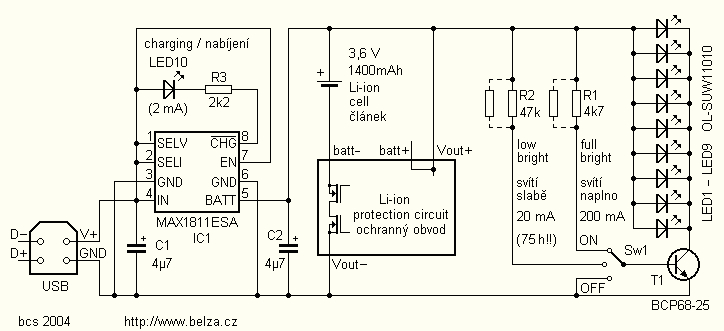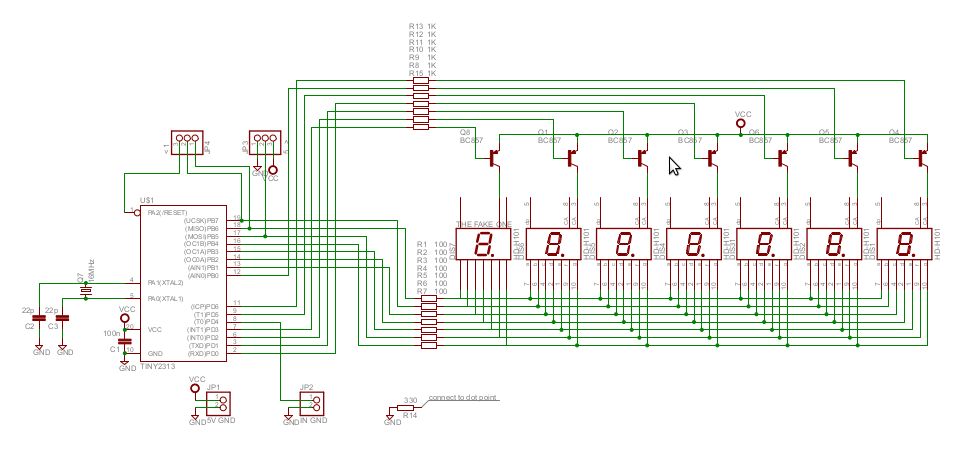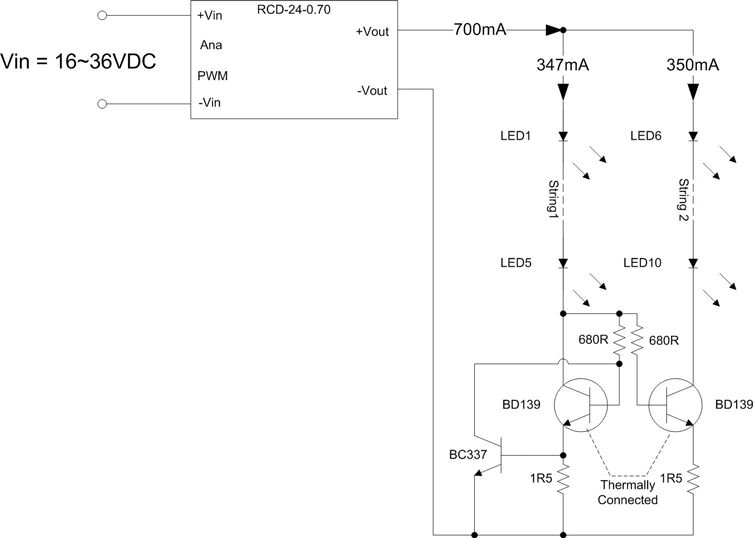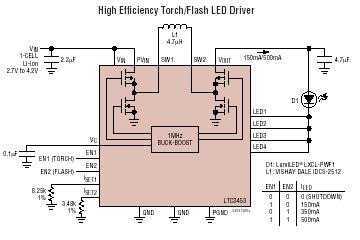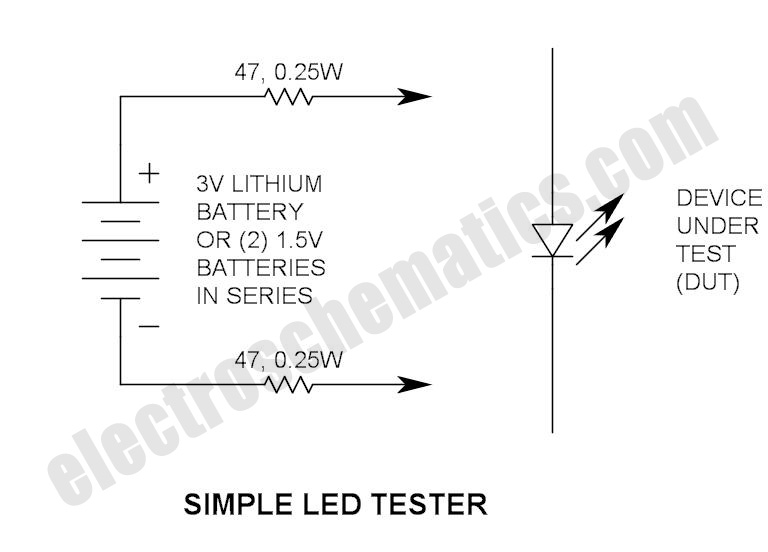
Multicolor HD LED
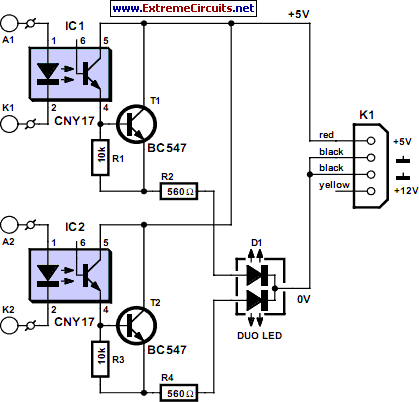
Most PC enclosures provide only a single LED to indicate hard disk access, which is connected to the motherboard via a two-pin connector. However, this LED only functions with IDE drives, and if a SCSI disk controller is installed, its activity will not be visibly indicated. This small circuit addresses that issue by utilizing a multicolour LED. The activity LED for the IDE interface is typically driven by a connected device through one or more open-collector stages, illuminating when either of the two possible IDE drives is activated. A shared series resistor limits the current and offers short-circuit protection. Even if the LED is shorted due to faulty wiring, the current is constrained to a safe level. An obvious solution would be to have the IDE and SCSI disks drive a shared dual LED; however, the current flows from the positive supply line through a series resistor, the LED, and a transistor to ground. Consequently, the dual LED would require a common anode, but such a device does not exist, as all known multicolour LEDs have a common cathode lead. This presents a challenge, but a small additional circuit can enable the LED to be driven by different interfaces. In this circuit, each drive signal from the two controllers is routed to an optocoupler, which functions similarly to the original LED. The slightly lower voltage drop of the infrared LED results in marginally higher current, but overloading is not a significant concern. The optocouplers resolve the issues related to varying voltages. On the output side, a Darlington transistor, composed of a phototransistor and a BC547, drives the multicolour LED. A 10-kilohm resistor, whose value is not critical, ensures secure cutoff of the driver transistor. The base of the phototransistor in the CNY17 is left open. The series resistors for the individual LED elements are calculated using the standard formula, and adjustments may be necessary for relative brightness levels. The circuit can also operate from the +12-V power supply line if the series resistor values for the LEDs are suitably modified. If desired, an additional optocoupler stage can be included to allow for a three-colour LED (red, green, and blue) to be driven. The circuit board is designed to be compact, allowing components to be fitted quickly, with the entire assembly suspended from the LED in the PC enclosure. A drop of hot-melt glue can secure the circuit board against vibration. The supply voltage is provided to the circuit through a standard small drive connector for ease of access, although ordinary solder pins can also be utilized.
This circuit design enhances the functionality of hard disk activity indication in PC enclosures by integrating a multicolour LED that can signal activity from both IDE and SCSI drives. The use of optocouplers is crucial in this application, as they allow for electrical isolation between the drive signals and the LED, ensuring compatibility with different voltage levels. The Darlington transistor configuration amplifies the current to drive the multicolour LED effectively, while the series resistors are essential for current limiting and ensuring that each LED color operates within safe parameters.
When implementing this circuit, it is important to consider the characteristics of the specific multicolour LED being used, particularly its forward voltage and current ratings. The calculated series resistors for each LED segment should be adjusted to achieve uniform brightness across the colors. The option to utilize a +12-V power supply line provides flexibility in power management, particularly in systems where additional power sources may be limited.
The compact design of the circuit board is advantageous for installation in tight spaces within PC enclosures, and the use of hot-melt glue for securing the board enhances reliability. Overall, this circuit serves as a practical solution for improving hard disk activity indication in systems utilizing both IDE and SCSI interfaces, providing users with a clear visual representation of drive activity.Most PC enclosures provide only a single LED to indicate hard disk access, with the LED being connected to the motherboard via a two-pin connector. However, this LED only works with IDE drives, and if a SCSI disk controller is fitted, its activity will not be visibly noticeable.
This small circuit remedies that problem using a multicolour LED. The activity LED for the IDE interface is usually driven by a connected device via one or more open-collector stages. It illuminates if either of the two possible IDE drives is activated. The shared series resistor limits the current and also provides short-circuit protection. Even if the LED is shorted out due to faulty wiring, the current is restricted to a safe level. An obvious solution would be to have the IDE and SCSI disks drive a shared dual LED, but unfortunately the current flows from the positive supply line through a series resistor, the LED and a transistor to ground. The dual LED would thus have to have a common anode, but no such device exists. All known multicolor LEDs have a common cathode lead. That means they cannot be connected directly, but we`re not that easily defeated. Only a small additional circuit is needed to allow the LED to be driven by the different interfaces. In this circuit, each of the drive signals from the two controllers is fed to an optocoupler, which acts nearly the same as the original LED.
The somewhat lower voltage drop of the infrared LED results in a somewhat greater current, but there`s hardly any need to worry about overloading. The optocouplers eliminate the problems with the different voltages. On the output side, a Darlington transistor consisting of the photo-transistor and a BC547 drives the multicolour LED.
The 10-k resistor (whose value of is not critical) provides secure cut-off of the driver transistor. The base of the phototransistor in the CNY17 is left open. The series resistors for the individual LED elements are dimensioned using the standard formula. It may be necessary to adjust their values slightly, depending on the relative brightness levels. The circuit can also operated from the +12-V line of the power supply if the values of the series resistors for the LEDs are suitably modified. If necessary, a third optocoupler stage can be added to allow a three-colour LED (red, green and blue) to be driven.
The circuit board has been designed to be so small that the components can be fitted in a few minutes and everything can be suspended from the LED in the PC enclosure. A drop of hot-melt glue will prevent the circuit board from becoming dislodged due to vibration. The supply voltage reaches the circuit via a normal small drive connector, to make it easy to obtain the necessary plug.
Otherwise, you can also use ordinary solder pins. 🔗 External reference
This circuit design enhances the functionality of hard disk activity indication in PC enclosures by integrating a multicolour LED that can signal activity from both IDE and SCSI drives. The use of optocouplers is crucial in this application, as they allow for electrical isolation between the drive signals and the LED, ensuring compatibility with different voltage levels. The Darlington transistor configuration amplifies the current to drive the multicolour LED effectively, while the series resistors are essential for current limiting and ensuring that each LED color operates within safe parameters.
When implementing this circuit, it is important to consider the characteristics of the specific multicolour LED being used, particularly its forward voltage and current ratings. The calculated series resistors for each LED segment should be adjusted to achieve uniform brightness across the colors. The option to utilize a +12-V power supply line provides flexibility in power management, particularly in systems where additional power sources may be limited.
The compact design of the circuit board is advantageous for installation in tight spaces within PC enclosures, and the use of hot-melt glue for securing the board enhances reliability. Overall, this circuit serves as a practical solution for improving hard disk activity indication in systems utilizing both IDE and SCSI interfaces, providing users with a clear visual representation of drive activity.Most PC enclosures provide only a single LED to indicate hard disk access, with the LED being connected to the motherboard via a two-pin connector. However, this LED only works with IDE drives, and if a SCSI disk controller is fitted, its activity will not be visibly noticeable.
This small circuit remedies that problem using a multicolour LED. The activity LED for the IDE interface is usually driven by a connected device via one or more open-collector stages. It illuminates if either of the two possible IDE drives is activated. The shared series resistor limits the current and also provides short-circuit protection. Even if the LED is shorted out due to faulty wiring, the current is restricted to a safe level. An obvious solution would be to have the IDE and SCSI disks drive a shared dual LED, but unfortunately the current flows from the positive supply line through a series resistor, the LED and a transistor to ground. The dual LED would thus have to have a common anode, but no such device exists. All known multicolor LEDs have a common cathode lead. That means they cannot be connected directly, but we`re not that easily defeated. Only a small additional circuit is needed to allow the LED to be driven by the different interfaces. In this circuit, each of the drive signals from the two controllers is fed to an optocoupler, which acts nearly the same as the original LED.
The somewhat lower voltage drop of the infrared LED results in a somewhat greater current, but there`s hardly any need to worry about overloading. The optocouplers eliminate the problems with the different voltages. On the output side, a Darlington transistor consisting of the photo-transistor and a BC547 drives the multicolour LED.
The 10-k resistor (whose value of is not critical) provides secure cut-off of the driver transistor. The base of the phototransistor in the CNY17 is left open. The series resistors for the individual LED elements are dimensioned using the standard formula. It may be necessary to adjust their values slightly, depending on the relative brightness levels. The circuit can also operated from the +12-V line of the power supply if the values of the series resistors for the LEDs are suitably modified. If necessary, a third optocoupler stage can be added to allow a three-colour LED (red, green and blue) to be driven.
The circuit board has been designed to be so small that the components can be fitted in a few minutes and everything can be suspended from the LED in the PC enclosure. A drop of hot-melt glue will prevent the circuit board from becoming dislodged due to vibration. The supply voltage reaches the circuit via a normal small drive connector, to make it easy to obtain the necessary plug.
Otherwise, you can also use ordinary solder pins. 🔗 External reference
